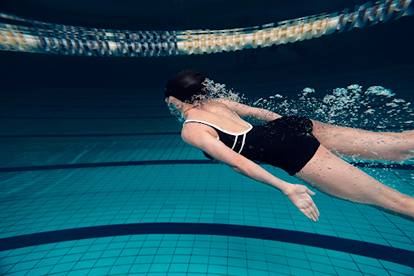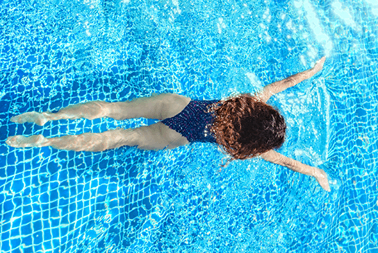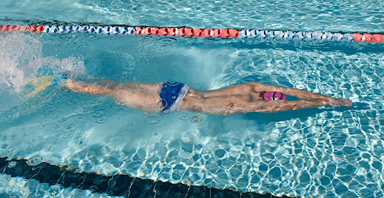Gliding in Swimming: Your Key to Efficiency and Speed

When you think about swimming faster, your first thought might be kicking harder or pulling stronger. But here’s the secret: real efficiency in the water doesn’t always come from working harder, but comes from moving smarter. That’s where gliding in swimming steps in.
In this article, we’ll break down what gliding and push techniques are, why they’re so important, how you can improve them, and some common mistakes swimmers often make along the way.
What is Gliding in Swimming?
Gliding in swimming is all about moving smoothly and efficiently through the water right after you push off the pool wall or finish a stroke. Think of it as the free ride moment in swimming. You’re not actively kicking or pulling, but your body is still moving forward thanks to the momentum you’ve created.
During a proper glide, your body should be long and streamlined: arms stretched out in front, legs together, toes pointed, and head in line with your spine. This position helps reduce drag, allowing you to travel further with less effort.
Even though gliding might look passive, it’s actually a skill that takes awareness and control. Beginners often skip it too quickly, wasting energy and breaking their rhythm. When done right, though, gliding boosts your speed, makes your strokes more efficient, and gives you a smoother overall swim.
Why Is Gliding in Swimming Important?
Gliding might seem like just a pause between strokes, but it’s actually one of the biggest secrets to swimming smarter, not harder. When you learn to glide properly, you move more efficiently, save energy, and even swim faster. Let’s break down why gliding in swimming is so important:
1. Reduces Drag and Increases Speed
A good glide keeps your body tight and streamlined, cutting down water resistance. With arms stretched, head aligned, and legs together, you move further and faster without extra effort.
2. Conserves Energy and Builds Endurance
Gliding gives your body a quick rest while still moving forward. This helps save energy, prevents early fatigue, and makes it easier to swim longer distances.
3. Improves Stroke Timing and Rhythm
Adding glide phases helps smooth out your swimming rhythm. Instead of rushing, you’ll move with better flow and balance, making each stroke more effective.
4. Enhances Body Control and Awareness
Holding a streamlined position during glides teaches you to notice the head, core, and leg alignment. This builds body awareness and prepares you for advanced techniques later.
5. Boosts Push-Off and Start Performance
The glide after a push-off or dive sets the tone for your whole swim. A strong, streamlined glide lets you cover more distance right from the start, giving you an early advantage.
How to Improve Your Gliding Technique
Knowing the importance of gliding in swimming is one thing, but actually mastering it takes practice. Luckily, there are plenty of simple swimming drills you can try in the pool to sharpen your glide, improve body awareness, and make your movements more efficient. Here are some of the best glide-focused drills to add to your training:
A. Glide & Kick Drill

Push off the wall, hold your glide, then add a gentle flutter kick without using your arms. This helps you feel body alignment and learn how to balance stillness with propulsion.
B. 3-Second/2-Count Glide

After each stroke or kick, pause and glide for three seconds (or two counts). This builds discipline, improves rhythm, and prevents you from rushing through strokes.
C. Pullout-Only Drill

Pullout-Only Drill is great for breaststroke training. Start by push off, do the underwater pullout, and glide without continuing strokes. It builds core control, underwater endurance, and better efficiency during starts and turns.
D. Arms-With-Glide Only (Pull Buoy)
.png)
Place a pull buoy between your legs to remove the kick. Focus on arm pulls followed by a short glide. This teaches how far one stroke can carry you when done correctly.
E. Kick & Glide With Fins

Fins give you extra power, exaggerating the glide phase. It helps you spot drag or alignment issues more easily and builds confidence, especially for beginners.
F. Push-Off & Glide (Freestyle)
.png)
Push off the wall in a tight streamline and glide as far as possible without strokes or kicks. This drill shows how much distance good body form alone can create.
G. Streamlined Flutter Kick/Torpedo

This move reinforces core strength, balance, and endurance while keeping your body long and straight.
Common Gliding Mistakes to Avoid
Even though gliding in swimming is a powerful tool for efficiency, it’s easy to get it wrong. Small mistakes can slow you down, waste energy, and throw off your rhythm. Here are some of the most common glide errors and how to avoid them:
1. Gliding for Too Long
Gliding is great, but overdoing it makes you lose speed and sink slightly. This breaks your rhythm and forces you to work harder to pick up pace again. Keep your glide short and efficient instead of stretching it endlessly.
2. Starting the Pull Too Early / Skipping the Glide
Rushing into the next stroke or skipping the glide altogether removes one of the easiest ways to move forward with less effort. Give your body time to use the momentum you’ve already created before starting the next pull.
3. Overstretching the Arms
Reaching too far can lock your elbows, drop your arms, and create drag. Aim for a natural, streamlined extension with arms in line with your ears.
4. Dropping Hands or Elbows
When your hands or elbows slip out of line, your streamline falls apart. This increases resistance and disrupts balance. Keep your arms firm, straight, and supported by your core for a smoother glide.
5. Raising the Palm (“Stop” Motion)
Pointing your palms upward acts like a brake and kills momentum. Instead, keep your palms slightly angled down and in line with your forearms, letting water flow cleanly past.
Want to Swim Faster with Less Effort?
Gliding in swimming is all about finding that balance between effort and efficiency. The stronger your push-off and the cleaner your glide, the smoother your entire swim will feel. So the next time you hit the pool, pay attention to your glide.
The Swimming Program in Rockstar Academy is designed to help kids and teens build strong water skills, boost confidence, and develop discipline while still having fun.
As part of the Sports & Performing Arts Academy, the program combines professional coaching with a supportive environment where students can grow both as swimmers and as individuals.
Training is structured to prepare them for real challenges, including the exciting RockOlympics competition, where they get to showcase their progress and celebrate achievements with their peers.
For those curious to experience the program firsthand, Rockstar Academy also offers a free trial. Go claim your free trial class now!
FAQ
What is gliding in swimming?
Glide in swimming is the smooth, streamlined movement through the water after a push-off or stroke, using momentum instead of active strokes or kicks.
What is the difference between swimming and gliding?
Swimming involves continuous strokes and kicks for propulsion, while gliding is the pause where the body rides momentum in a streamlined position.



